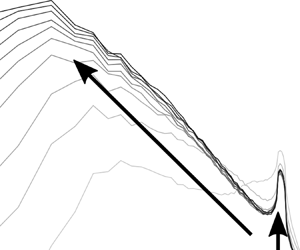Article contents
Inverse transfer of magnetic helicity in direct numerical simulations of compressible isothermal turbulence: scaling laws
Published online by Cambridge University Press: 11 March 2021
Abstract

The inverse transfer of magnetic helicity is investigated through direct numerical simulations of large-scale mechanically driven turbulent flows in the isothermal ideal magnetohydrodynamics framework. The mechanical forcing is either purely solenoidal or purely compressive and the turbulent statistically stationary states considered exhibit root mean square (RMS) Mach numbers  $0.1 \lesssim {\mathcal {M}} \lesssim 11$. A continuous small-scale electromotive forcing injects magnetic helical fluctuations, which lead to the build-up of ever larger magnetic structures. Spectral scaling exponents are observed which, for low Mach numbers, are consistent with previous research done in the incompressible case. Higher compressibility leads to smaller absolute values of the magnetic helicity scaling exponents. The deviations from the incompressible case are comparatively small for solenoidally driven turbulence, even at high Mach numbers, as compared with those for compressively driven turbulence, where strong deviations are already visible at relatively mild RMS Mach numbers
$0.1 \lesssim {\mathcal {M}} \lesssim 11$. A continuous small-scale electromotive forcing injects magnetic helical fluctuations, which lead to the build-up of ever larger magnetic structures. Spectral scaling exponents are observed which, for low Mach numbers, are consistent with previous research done in the incompressible case. Higher compressibility leads to smaller absolute values of the magnetic helicity scaling exponents. The deviations from the incompressible case are comparatively small for solenoidally driven turbulence, even at high Mach numbers, as compared with those for compressively driven turbulence, where strong deviations are already visible at relatively mild RMS Mach numbers  ${\mathcal {M}}\gtrsim 3$. Compressible effects can thus play an important role in the inverse transfer of magnetic helicity, especially when the turbulence drivers are rather compressive. Theoretical results observed in the incompressible case can, however, be transferred to supersonic turbulence by an appropriate change of variables, using the Alfvén velocity in place of the magnetic field.
${\mathcal {M}}\gtrsim 3$. Compressible effects can thus play an important role in the inverse transfer of magnetic helicity, especially when the turbulence drivers are rather compressive. Theoretical results observed in the incompressible case can, however, be transferred to supersonic turbulence by an appropriate change of variables, using the Alfvén velocity in place of the magnetic field.
Information
- Type
- JFM Papers
- Information
- Copyright
- © The Author(s), 2021. Published by Cambridge University Press
References
REFERENCES
- 3
- Cited by


